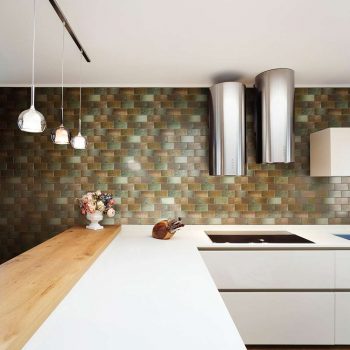Delivery and Storage
Please ensure that suitable access is available. The products will arrive on 18-26 tonne vehicles (this is approximately the size of a fire engine). The driver will endeavour to offload the paving as close as possible to where you would like them. It is essential that we are informed of any access issues (e.g. narrow lanes/overhead restrictions/difficult site conditions/restricted parking). If we do not have prior warning we cannot be held responsible for not offloading.
The tiles, in the main, will arrive on shrink wrapped pallets approx 14m2 to 39m2 per pallet (dependent on stone type and thickness). Please check all goods and report any items that may have been omitted from the delivery. This ensures that replacements are dispatched in a timely manner in order to avoid delays.
Packaging may experience condensation, which can damage the product surface. If extreme temperature changes are anticipated, remove outer plastic packaging and ensure stones are protected from adverse weather.
Before installing natural stone wall tiles, transfer the tiles to the area in which they are to be laid to allow them to acclimatise overnight at room temperature.
Radiators and heat sources in the room including range cookers should be turned off during the laying and drying out process. This will prevent rapid drying which may lead to grout shrinkage and hairline surface fissures. However, a minimum background temperature of 15°C will be required for sealing.
Weight Limits For Individual Types Of Substrates
The type of surface the tiles have to be fixed to will determine the choice of tile. The following table shows the weight limits for various substrates. This is in accordance with the relevant information contained within BS 5385 – Wall and floor tiling.
Preparation Of Internal Areas and Tiles
Remove all loose and friable material from the back of the tiles.
A few tiles may have small chips and blemishes. These are generally used for cuts. An allowance of 5% extra on your room measurements should take into account for cuts and to cover reasonable breakages or mishandling.
When the tiles are completely dry and clean, the surface of the tile should be saturated with at least one coat of Lithofin MN Stain-Stop prior to installing natural stone wall tiles.
Cutting should be done with a diamond cutter.
Note: The room should be well ventilated during sealing and at minimum temperature of 15°C.
Further coats of sealant may be applied to the tile surface for added protection or enhanced appearance. This may be done once the grout is cured and the area clean, dry and free of any dirt or loose particles. Do not allow the sealant to puddle and remove surplus with a cloth.
Setting Out
It is recommended that the tiles are mixed prior to installation to achieve a harmonious appearance of colours and shades as colour variation always occur to some extent, even in the same batch.
Tiling should be set out from the centre of the walls. Either the centre of a tile in the centre of the wall or the joint between two tiles in the centre of the wall, whichever option will avoid small cuts of the tiles.
Make a gauge rod using a length of straight timber. Along the length of the timber, mark out the width of the tiles, leaving a gap at least 2mm wide between each tile. Set out the horizontal position of the tiles so that the same size cuts are made either side of windows etc, avoiding any small cuts. At the lowest point of the wall to which you are tiling, such as the skirting board, work surface etc place an uncut tile and draw a line along the top of the tile. Nail a batten below this line, using a spirit level to make sure that the line is straight. Start tiling at this centre point.
Tiling To Plaster Walls – Preparation
New plaster should be a minimum of 4 weeks old (including backing coat) and 1 week old for just a skim coat. It must be ensured that the plaster is sound, in good condition and firmly bonded to the background. Tiles should only be fixed to finishing plaster, not to the plaster backing coat. Any loose or hollow sounding areas should be cut out and made good.
If the plaster is dusty or has a shiny finish, it should be thoroughly dry brushed using a stiff bristle brush and the dust wiped from the surface, prior to the priming with a suitable primer diluted 1:4 with water. The maximum weight of tiling which plaster is able to support is 20kg/m2, generally equivalent to a ceramic tile with a maximum thickness of 8mm or natural stone with a maximum thickness of 7mm.
Tiling To Plasterboard Walls (unskimmed) – Preparation
The plasterboard should be dry, securely fixed and rigid with no protruding fixings and face to receive decorative finish exposed. It should be a minimum 12.5mm thick when fixing to timber framing or battening and fixed in accordance with the manufacturers recommendations.
The maximum weight of tiling should not exceed 32kg/m2 (including the weight of adhesive). This is generally equivalent to ceramic tiles with a maximum thickness of 12.5mm and natural stone with a maximum thickness of 10mm. Plasterboard is not generally considered to be a satisfactory background for tiling in frequently wet areas. Tanking with wet seal membrane is required in these areas.
Tiling To Backer Board – Preparation
The tile-backer board should be dry, securely fixed and rigid with no protruding fixings. Again, this must be fixed in accordance with the manufacturers recommendations.
The maximum weight of tiling should not exceed 40-50kg/m2 (including the weight of adhesive). This is generally equivalent to natural stone with a maximum thickness of 20mm. Heavy tiles must be fully supported until the adhesive has fully dried.
Consideration should be given to tanking with wet seal membrane in areas subject to wetting.
Tiling To Blockwork Walls – Preparation
The blockwork must be at least 6 weeks old to enable movement caused by drying shrinkage to have taken place before either direct tile fixing or application of a sand: cement render coat takes place. The blockwork must be fair-faced and sufficiently flat to receive a tile finish. If in doubt then a cement: sand render coat should be applied.
Lightweight or medium weight blockwork is not suitable to receive a tiled finish in external conditions or installations which may be subject to wetting. In these instances, a cement: sand render coat should be applied. There is no specific guidance on weight limit of tiles for blockwork. It is generally considered that tiles up to 20mm thick are suitable giving a weight limit of 40-50kg/m2.
Lightweight and medium weight blockwork should be primed with a suitable primer diluted 1:4 with water prior to tiles being fixed. In all instances it must be ensured that the blockwork is clean, dry and free from dust, laitance or any contaminants which may act as a release agent and prevent the adhesive from bonding to the surface. If the blockwork is dusty, dry brush with a wire brush and remove the loose dust. Brush apply primer diluted 1:4 with water, to seal the surface. Allow to dry.
Tiling To Render Walls – Preparation
The render must be at least 2 weeks old to enable movement caused by drying shrinkage to have taken place. The render must be clean, dry and free from dust, laitance or any other contaminants which may act as a release agent and prevent the adhesive from bonding to the substrate. If the render is dusty, dry brush with a wire brush and remove the loose dust. Brush apply primer, diluted 1:4 with water, to seal the surface. Allow to dry.
Tiles up to a maximum of 20mm thick may be fixed to cement: sand render backgrounds in good condition. Ensure tiles are fully supported until the adhesive has fully dried.
There is no specific guidance on weight limit of tiles for blockwork. However, it is generally considered that tiles up to 20mm thick are suitable giving a weight limit of 40-50kg/m2.
Tile Fixing
For substrates that have to be primed, prior to commencing the tiling, ensure that the primer has dried. Fix the tiles in a 3mm thick solid bed (i.e. ensuring no voids remain beneath the tiles) of one part flexible white adhesive. Gradually add 3.5 parts of adhesive powder to 1 part of clean cold water and stir until a smooth lump free consistency is achieved. Mix only enough material that can be used within the pot life of the product (around 4 hours at 20°C).
Using a suitable notched wall trowel held at a 45° angle, spread the adhesive onto the floor to form parallel ribs into which the tiles should be pushed with a firm twisting action. This will collapse the ribs of adhesive and produce a 2-3mm solid bed of adhesive beneath the tiles.
Work in small areas and discard any adhesive that begins to dry or ‘skin over’. Tiles with deeply keyed back profiles may need to be back buttered. In areas subject to wetting, such as showers, it is essential that a solid bed of adhesive is achieved beneath the tiles. Wipe off any adhesive residues from the surface of the tiles using a damp sponge before the adhesive sets. Remove deposits of adhesive which may build up in the gaps between the tiles.
Tile Grouting
Allow the adhesive to dry. The joints should be filled using a suitable stop mould grout. Clean out any dust, dirt and adhesive from between the tiles and make sure that the joints are dry.
Approximately 3 parts grout powder should be added to 1 part water. Please ensure that the powder is added to the liquid to prevent the product from flash setting. Manually mix the grout to reduce the amount of air incorporated into the mix. Holding a soft rubber grout float at 45°, sweep the mixed grout diagonally across the tiles, ensuring that the grout is pushed fully into the joints. Clean off as much grout from the surface of the tiles as possible and allow the grout to become touch dry.
Clean off the grout residues with a damp sponge wiped diagonally across the tiles. Allow the tiles to dry and buff the surface with a dry cloth. Any stubborn residues may be cleaned off with washing up detergent mixed with warm water within 24 hours of grouting.
NB. Before grouting commences trial a small area to check that the grout does not stain the tiles. If there is any risk of staining, the tiles should be fully sealed using a proprietary sealer before the grouting begins.
Note: All the adhesives and grout mortars used to fix the stones should be mixed in accordance with the instructions given on the manufacturers’ product data sheets and bag instructions.

